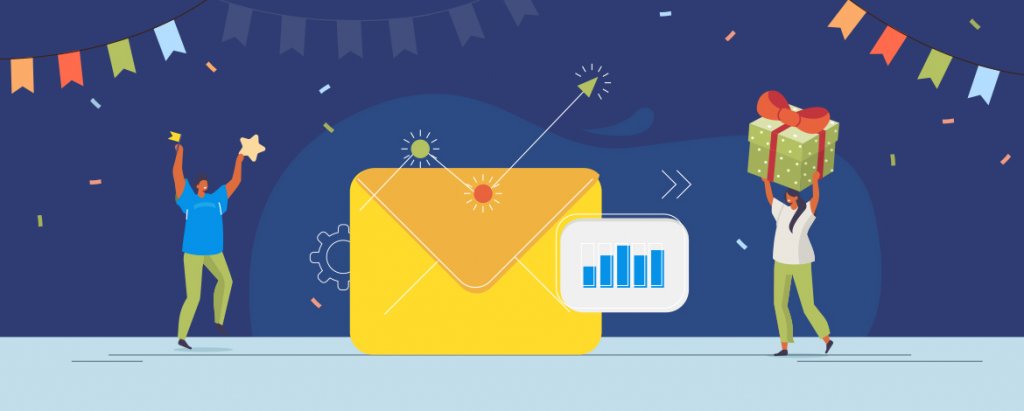As the holiday season approaches, it’s a crucial period for many retailers, with seasonal campaigns playing a vital role in year-end revenue. A well-executed omnichannel strategy—integrating email with SMS, social media, and even interactive in-store experiences—can boost engagement by reaching customers at just the right moments throughout the holiday season.
Statistics show that holiday emails alone can drive up to 25% of annual retail revenue, with targeted campaigns performing 30% better than non-targeted ones. To help you succeed, we’ve compiled top strategies with real-life examples to make your holiday campaigns shine.
How to Create High-Impact Messaging
Holiday shoppers vary from early-bird planners to last-minute rushers. Segmenting your audience by shopping habits, demographics, and past behavior lets you tailor messages that resonate with each group. Research shows that segmented campaigns can yield a 14% higher open rate, making personalization a cornerstone for holiday success. Here are some ways to segment effectively:
- Frequent Buyers: Offer exclusive discounts or VIP early access to your holiday collection.
- Gift Givers: Spotlight gifts tailored for different interests, age groups, and styles.
- New Subscribers: Highlight your most popular or limited-edition holiday items to welcome new customers.
Example 1: Starbucks Holiday Rewards Program
Starbucks segments its list based on customer loyalty and purchase behavior. For instance, Gold-level members may receive offers for a complimentary holiday drink, while newer members get extra points for purchases. Personalized offers create a sense of exclusivity and loyalty, leading to increased engagement.
Example 2: Brooklinen’s Holiday Comfort Campaign
Brooklinen, known for its quality bedding and home essentials, segments holiday emails based on purchase history and engagement level. Frequent buyers are offered exclusive holiday bundles and limited-time discounts on popular products like comforters and sheet sets. First-time shoppers receive holiday gift guides featuring best-sellers to make choosing easier, while subscribers who haven’t purchased recently are re-engaged with a “Cozy Refresh” promotion. By aligning holiday offers with each customer’s past activity, Brooklinen enhances relevance and increases the likelihood of holiday conversions.
Inspire with Creative Gift Ideas
Many customers appreciate guidance on what makes a great gift, especially during the holiday rush. Use email to inspire subscribers and help them discover products they may not have considered. Highlight popular and unique gift ideas, and include bundles that appeal to different tastes:
- Holiday-Themed Bundles: Curate themed gift boxes, like a “Warm Winter Nights” box with candles, blankets, and mugs.
- Limited-Edition Items: Highlight special holiday releases or seasonal bundles to spark urgency.
- Post-Purchase Thank You: Offer a special discount on a future purchase or suggest related products that go with their previous purchase.
Example 3: Etsy’s “Gift Finder” Campaign
Etsy’s “Gift Finder” email series showcases unique gift ideas by interest, such as “For the Cozy Homebody” or “For the Nature Lover.” Limited-edition items add a sense of scarcity and exclusivity, encouraging faster purchase decisions.
Example 4: Uncommon Goods’ “Holiday Gift Guide” Series
Uncommon Goods uses a “Holiday Gift Guide” email series to spotlight unique and handmade products based on recipient type and interests, like “For the Quirky Cook” or “For the Outdoor Adventurer.” They feature themed bundles with curated items and highlight limited-edition artisan products that are only available during the holidays. Post-purchase emails include a thank-you note along with suggestions for complementary items, encouraging additional purchases. This strategy inspires shoppers and helps them discover thoughtful, distinctive gifts, enhancing both customer satisfaction and sales.
Make it Fun with Interactive Elements
Interactive emails can boost engagement by up to 22%. Try adding fun, seasonal elements that entertain and convert:
- Holiday-Themed Scratch Cards: Let subscribers reveal a special discount or free shipping.
- Countdown Timers: Build anticipation for sales or product drops.
- “Spin to Win” Wheels: Engage users with prize opportunities.
Example 5: Sephora’s “Holiday Beauty Wonderland” Game
Sephora’s interactive holiday game offers discounts through a “spin-to-win” feature, creating a playful experience that drives engagement and sales.
Example 6: REI’s “Holiday Adventure Quiz”
REI engages subscribers with a holiday-themed quiz called “Find Your Perfect Outdoor Gift.” Shoppers answer questions about their favorite outdoor activities, climate, and skill level, then receive tailored product recommendations based on their responses. This interactive approach not only entertains but also guides users toward relevant gift options, creating a personalized shopping experience that boosts engagement and drives purchases.
Use AR/VR to Enhance Shopping Experience
Augmented reality (AR) and virtual reality (VR) can enrich the holiday shopping journey, with AR increasing engagement rates by 45%. Through email, offer immersive experiences like:
- Virtual Try-Ons: Beauty brands can let users preview makeup shades.
- Holiday Decor Visualizations: Home decor brands can show customers how items might look in their space.
Example 7: IKEA’s AR Holiday Emails
IKEA uses AR tools in holiday emails, allowing customers to visualize furniture and festive decor in their rooms, making holiday purchases more compelling.
Example 8: Warby Parker’s “Virtual Try-On” for Holiday Frames
Warby Parker enhances its holiday emails by offering an AR “Virtual Try-On” feature, allowing subscribers to see how different eyeglass frames look on their faces before buying. Special holiday frames and limited-edition colors are highlighted, making the experience both interactive and seasonally relevant. This immersive feature helps customers feel more confident in their purchase, reducing hesitation and increasing holiday conversions.
Support Charity and Social Good
Show customers that your brand is about more than sales by giving back. With 71% of consumers preferring to buy from socially responsible brands, promoting charity is a smart strategy:

- Charity Partnerships: Pledge a portion of holiday sales to a cause.
- Customer Choice: Let customers choose which charity their purchase supports.
Example 9: TOMS “One for One” Holiday Campaign
TOMS reminds customers that each shoe purchase leads to a donation, appealing to those who value ethical shopping and reinforcing brand loyalty.
Example 10: Bombas “Holiday Giving Back” Campaign
Bombas promotes its mission of donating a pair of socks for every pair purchased through their “Holiday Giving Back” campaign. During the holiday season, they highlight stories of how their donations impact communities in need, making customers feel part of the mission. This approach not only boosts holiday sales but also resonates with socially conscious shoppers, reinforcing Bombas’ commitment to making a positive difference.
Overcome Holiday Email Marketing Challenges
The holiday season can overwhelm inboxes and elevate unsubscribe rates, with 49% of consumers feeling they receive too many holiday emails. Address these challenges to keep campaigns effective:
- Limit Frequency: Send only essential emails, segmenting by engagement level.
- Use Quality Visuals: Ensure emails are visually appealing and festive, without clutter.
- Maintain Opt-Out Options: Keep unsubscribe options visible and accessible.
Example 11: Patagonia’s Selective Holiday Emails
Patagonia uses a minimal holiday email approach with stunning visuals, reducing fatigue and keeping customers engaged.
Example 12: Everlane’s “Holiday Bestsellers” Email Series
Everlane sends a limited series of holiday emails, each one carefully curated to showcase only a small selection of their best-selling, sustainably-made items. The emails use elegant, minimalist visuals, focusing on one product per message—such as their popular Cashmere sweaters or Day Boots—without clutter or over-the-top holiday themes. Everlane also segments their audience based on engagement, sending fewer emails to less active subscribers to avoid overwhelming them. Each email has a prominently displayed opt-out option, reinforcing Everlane’s respect for customer preferences while still keeping their products top of mind for holiday shoppers.
Prioritize Compliance and Best Practices
Holiday campaigns should be engaging yet fully compliant with regulations like GDPR and CAN-SPAM. Protect your brand’s reputation by ensuring every email respects consent and provides easy opt-outs.
- Opt-In Only: Send emails only to those who have opted in. This avoids penalties and builds a trusting customer base.
- Clear, Concise Messages: Since 80% of people skim emails, keep your holiday messages short, readable, and impactful.
Example 13: REI’s “Opt Outside” Campaign
REI emphasizes transparency in its emails, providing clear opt-outs and respecting inbox preferences. This compliant, straightforward approach boosts consumer trust, especially during the busy holiday season.
End with a Warm, Festive Greeting
A heartfelt holiday message—focused on appreciation, not promotion—leaves a lasting impression. Research shows that 44% of consumers are more likely to become repeat buyers after a positive, personalized experience. Create a warm, festive email closer to Christmas to strengthen your relationship with subscribers.
Example 14: Anthropologie’s Christmas Eve Message
Anthropologie sends a holiday message on Christmas Eve, wishing customers a joyful season without a sales pitch, which enhances customer loyalty.
Make Every Channel Work Together
With inboxes crowded during the holidays, a coordinated omnichannel approach can increase visibility and reduce oversaturation. From emails to SMS to social media notifications, an omnichannel tool helps ensure seamless communication across platforms.
Example 15: Best Buy’s Omnichannel Holiday Approach
Best Buy uses emails, SMS, and app notifications to create a synchronized campaign. Starting in November, emails announce upcoming deals, while SMS reminders drive urgency closer to key dates. In-app updates offer convenience for last-minute shoppers, ensuring a smooth holiday journey.




